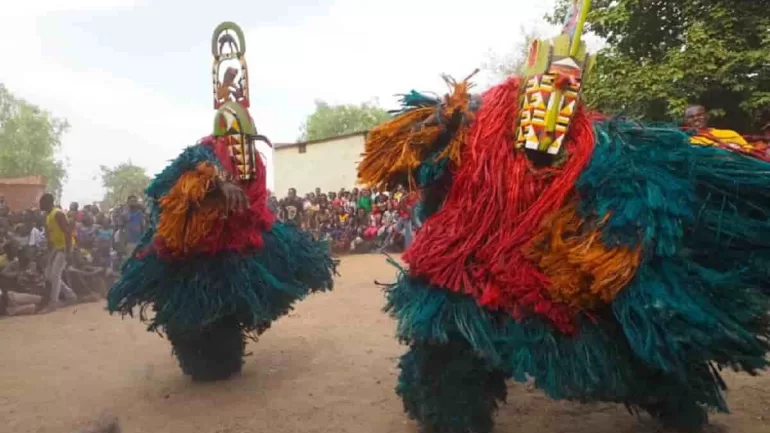ART & DESIGN
Headpiece carved by David Sanou in the studio of André Sanou is an example of contemporary African masquerade art. Photo: Lisa Homann. Courtesy of NOMA
From Nigeria to Cameroon, artists reinvent contemporary African masquerade art in this stunning dual-continent exhibition of masks and meaning at the New Orleans Museum of Art.
BY KAZEEM ADELEKE, ARTCENTRON
New African Masquerades: Artistic Innovations and Collaborations at the New Orleans Museum of Art (NOMA) is a groundbreaking exhibition. It redefines the boundaries of traditional West African masquerade art. Presented in partnership with the Musée des Civilisations noires (MCN) in Dakar, Senegal, this binational exhibition marks a historic first. It is the first of its kind to be shared across both North America and Africa. As a result, it fosters a dynamic and unprecedented cross-continental dialogue.
As global attention increasingly turns toward contemporary African art, New African Masquerades offers a timely exploration. The exhibition invites audiences to view the masquerade not only as a time-honored cultural ritual but also as a living and adaptive art form. It reflects personal creativity, societal transformations, and global interconnectedness.
Tradition Transformed: The Artistic Vision
The exhibition features the work of four celebrated artists: Chief Ekpenyong Bassey Nsa, Sheku “Goldenfinger” Fofanah, David Sanou, and Hervé Youmbi. Each artist brings a distinct perspective to the innovation of masquerade. Their practices bridge ancestral knowledge and modern aesthetics, reshaping how these masks and costumes function in contemporary culture.
Visitors encounter ensembles crafted from diverse and vibrant materials. These include wood, cloth, sequins, feathers, gourds, raffia, and cowry shells. Each element carries deep cultural symbolism. These elements are not merely decorative; they are deeply embedded in West African social, spiritual, and ceremonial life. At the same time, the artists’ reinterpretations demonstrate how masquerade is evolving. It has become a medium for critical expression, individual artistry, and global engagement.
Chief Ekpenyong Bassey Nsa: Spiritual Efik Masquerades
Chief Ekpenyong Bassey Nsa was born in 1973 in Creek Town, Nigeria. He belongs to the third generation of a family devoted to the Efik masquerade arts. His work is closely tied to the Ekpe secret society—a powerful traditional institution in southeastern Nigeria and western Cameroon.
Nsa’s practice continues his father’s pioneering efforts to modernize ceremonial ensembles. His work ranges from elaborately embroidered chieftaincy attire to funeral shrines, each piece beginning with ritual homage and spiritual invocation. Nsa blends deep-rooted symbolism with bold, modern aesthetics. In doing so, he emerges as both a custodian of tradition and a contemporary visionary.
Sheku Fofanah: Revitalizing Sierra Leone’s Masquerade Culture
In Freetown, Sierra Leone, Sheku “Goldenfinger” Fofanah has emerged as a master innovator of masquerade performance. As kotu (master builder) of the Gladiators Power Ordehlay Society, he reimagines central masquerade forms. These include the Jollay, Ordehlay, and Hunting dances.
Fofanah’s ensembles dazzle with intricate textile work, sequins, and hand-painted wood. His “Fairy” Masquerade Collection is a particularly vivid example of aesthetic daring and symbolic depth. His work has been exhibited internationally, including in Australia, Canada, and the United Kingdom. Through this global reach, he demonstrates how masquerade functions as both a local tradition and a global expression of identity and transformation.
David Sanou: Sculptural Mastery from Burkina Faso
From Bobo-Dioulasso, Burkina Faso, David Sanou brings sculptural finesse and creative reinvention to regional mask traditions. A third-generation artist, he has led his family’s studio since 2009, introducing new styles while preserving ancestral forms.
His “Compromise Kimi” headpieces often honor the recently deceased. These pieces integrate tradition with personal symbolism, serving as both memorial and artwork. One notable example, The Kimi Masquerade in Honor of André Sanou, showcases his ability to merge formal elegance with cultural storytelling. This work affirms the central role of masquerade in Burkina Faso’s social and spiritual life.
Hervé Youmbi: Interrogating Power and Identity in Global Contexts
Hervé Youmbi was born in Bangui, Central African Republic, and raised in Cameroon. He works at the intersection of ritual, history, and contemporary critique. Known for his hybrid masks and striking portraiture, Youmbi uses masquerade to challenge the boundary between “traditional” and “contemporary” African art.
His Tso Scream Mask series—crafted from wood, fiber, beads, and textiles—explores complex themes. These include postcolonial identity, power structures, and cultural memory. His work has appeared in major institutions such as the Louvre Abu Dhabi and the Smithsonian’s National Museum of African Art. Through these platforms, he shows how masquerade can confront political and historical forces that shape African societies today.
Themes of Continuity and Change
Although rooted in diverse regional traditions, all four artists share a common goal. They seek to reinterpret masquerade as a living, fluid art form. Each artist blurs the lines between ritual and exhibition, performance and object, local culture and global discourse.
This thematic richness invites viewers to reconsider masquerades. Rather than viewing them as static ethnographic artifacts, the exhibition presents them as contemporary expressions of resilience, innovation, and cultural negotiation.
Global Reach and Community Engagement
A defining feature of New African Masquerades is its transcontinental journey. The exhibition’s North American circuit includes stops at the New Orleans Museum of Art, the Frist Art Museum in Nashville, and the National Museum of African Art at the Smithsonian. Starting in Spring 2026, it will also travel to multiple venues across Africa.
This dual-hemisphere model ensures broad visibility and cultural reciprocity. It engages audiences in the artists’ local communities as well as in international art centers.
A Living Art Form in Motion
New African Masquerades repositions West African masquerade traditions at the heart of global contemporary art. Through artistic innovation, spiritual depth, and cross-cultural collaboration, the exhibition challenges reductive views of African art. It instead celebrates the vitality, complexity, and evolving future of the continent’s creative expressions.
A richly illustrated catalog accompanies the exhibition. It offers a rare opportunity to see how art can honor the past, shape the present, and inspire the future.
Don’t miss this powerful tribute to one of Africa’s most dynamic artistic legacies.
